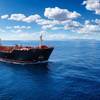Volvo Penta Powers Hybrid Scandinavian Ferries
Volvo Penta to power three hybrid and hybrid-ready ferries currently being built at GS Marine Production AS.
GS Marine is currently building a new ferry for Faroe Island operator, Standfaraskip Landsins. This ferry will have a speed of 20 knots and be powered by two of Volvo Penta’s engines. The D13-700 IMO III engines have a power output of 515kW at 2,250 rpm and will be coupled with a Brunvoll hybrid control system – allowing the vessel to run on the engines or electric alone, and even both in unison. Still under construction, this ferry will not be fitted with diesel gensets, as the engines will, through the electric motor connected to the gear, act as generator. This means that the Volvo Penta engines will supply all energy on board – in addition to plug-in facility when in port. Delivering near-zero-emissions, as well as high speed at sea, this ferry will be a welcome addition to Strandfaraskip’s growing fleet of hybrid boats.
In April 2019 GS Marine delivered the first of two, hybrid and hybrid-ready ferries to Norwegian operator Norled AS. With a 10-year contract to operate the Haugesund-Røvær-Feøy route Norled invested in this new technology. The Fjordled ferry is the first hybrid boat operating in Norway, and her sister vessel Fjordöy is set to join her late this year.
Cutting edge technology cuts emissions
These ferries are powered by two Volvo Penta D13 MH engines – both producing 441 kW at 1,900 rpm. The Fjordled ferry uses Volvo Penta IMO Tier III emissions compliant engines. Volvo Penta’s IMO III engine and after-treatment concept is a global solution for commercial marine operators. The Selective Catalytic Reduction System (SCR) is based on both Volvo Penta’s own experience in powering industrial off-road applications and the wider expertise of the Volvo Group.
In addition to the engines, the boat has two electric motors – with power outputs of 85 kW at 2,100 rpm – that are mounted directly on gears. The battery pack consists of three strings with a total of 140 kWh capacity (110 kWh is usable capacity). Due to the large battery capacity, there is no need to use standard generators to provide electric energy, allowing an uninterrupted power supply to electric and electronic systems on board.
“In Battery mode, the Fjordled is capable of 11 knots, but only 6-7 knots are required for harbor steaming,” explains Ingebjørn Aasheim, Naval Architect at GS Marine. “In Battery mode the boat is close to silent, which is much appreciated by locals and when passing popular marinas. Harbor steaming is approximately 30% of the operation, using electro-propulsion gives a better load profile on the engines, which in time results in less maintenance.”
“Additionally, the Volvo Penta engines can run on HVO fuel as well as diesel,” explains Richard Johansson, Area Sales Manager at Volvo Penta. “When you combine the SCR technology with HVO fuel you not only reduce NOx you also reduce CO2 significantly. Add the fact that they can also be powered by batteries and you have an extremely efficient system.”
These new hybrid vessels are equipped with SCR exhaust after treatment certified for IMO tier III, and meet future environmental requirements. Overall, these vessels emit 80 percent less NOx than the previous ferries traveling this route.
These moves towards electromobility are vital if Norway is to achieve its long-term goal of becoming a ‘low carbon society’ by 2050 – with an 80-95% reduction below its 1990 carbon levels. However, current infrastructure cannot support full-electromobility and electric vessels cannot currently travel long distances.














